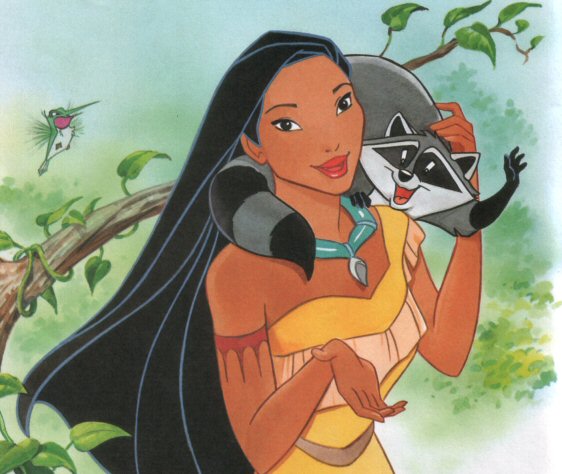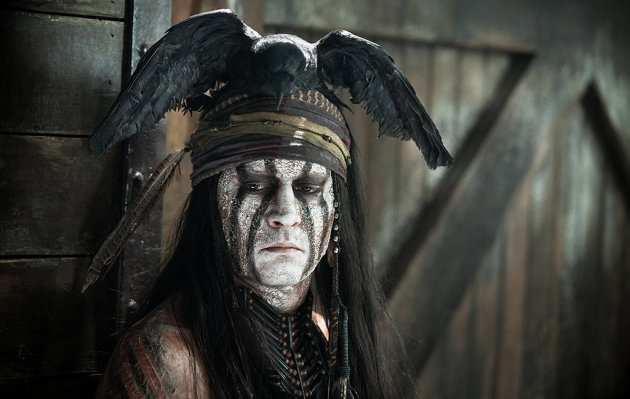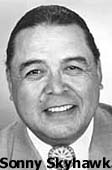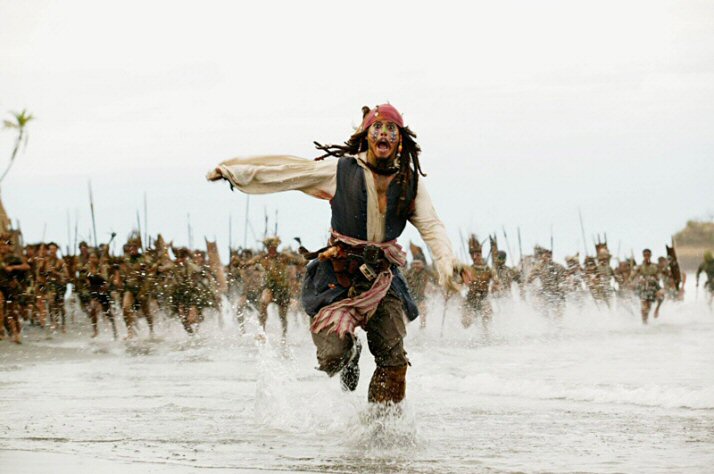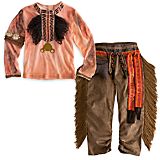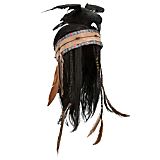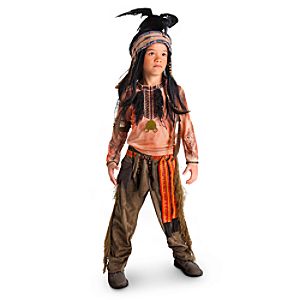Dani Miller takes Johnny Depp and Disney to task for hurting or failing to help Indians:
Earth to Johnny Depp
By Danielle MillerSoon after word of Lone Ranger filming, a video was released of Johnny Depp announcing the Gathering of Nations Pow wow. Was this truly an act of good faith, or just a Public Relations stunt meant to assuage his role of perpetuating red face? Many critiqued the video saying the way he acted seemed contrived. Others said his demeanor was an attempt to be cautious and respectful. My deduction of his actions is that Johnny Depp is misguided in his perceptions of Native Americans, like many celebrities and Americans.
Another rumor of a PR Stunt has created buzz online and through the moccasin telegraph; the claim that Johnny Depp is looking to buy Wounded Knee. In Episode 3 of “Rez Round up” Chase Iron Eyes was effective in summing up how many Natives feel about those claims. If this rumor was started as another PR stunt to generate buzz for Lone Ranger, then that is shameful. Of course if the purchase is made it will be appreciated. But it is very frustrating to see claims published with no action.
Chase made the great suggestion to Johnny Depp that he put money towards building an interpretive center to allow tribes to tell their stories. Allowing tribes to tell their own stories is very effective in healing from historical trauma and genocide. It is also effective in decreasing current instances of stereotyping and marginalization. That historical burden of our past is inevitable, but it’s not until we own our own history that we will truly be able to heal and move forward. Historical trauma doesn’t have to keep us feeling victimized or stagnant; it is a reminder to move forward and be empowered for the future we seek. Part of owning our history and identities is also about asserting respect for ourselves and how we are represented. Stereotypes erase culture; they keep natives stagnant and frozen in time. Stereotypes lead to dehumanization which escalates from racism to larger acts of violence. NOW is the time to address these issues to ensure respect, safety and equality for future generations.
In conclusion, some Natives are fans of Johnny Depp, and that’s what made the Lone Ranger so difficult to address. Opinions vary across communities. However, one can still be a fan of Johnny Depp while fighting for respectful representations of their people. True display of respect and honor is showing that you are willing to do what you can to correct situations of injustice. It’s never too late to do the right thing.From Donald Duck to the Wooster group: Di$ney Imperialism Propaganda Hidden in Plain Sight
By Dani MillerThe study “How to Read Donald Duck” analyzed Disney comics to find the effects it had on Chilean children. The results were truly disturbing. What’s even more disturbing is how relevant much of this research still is to Disney cartoons today. Although comics are a different medium many of the individualistic and imperialist attitudes still persist in Disney films. Many critique Disney for their lack of accurate representation of people of color in their films and the absence of parents reflecting the individualistic ideologies they push.
According to NY Times “Mr. Dorfman and Mr. Mattelart concluded the comics taught Chilean children not to rebel against their country’s dependent position in the international capitalist economic system…their conclusion was upheld when the general who overthrew the Government gained support by appealing too many of the values and cultural images imbued in the Disney texts.” It also encompasses the dichotomy of the savage vs. civilization. The book was so controversial that it was banned when it was published.
Could this same concept of propaganda against resistance be occurring in American media? Perhaps this is the reason that Disney continues to push imagery which stereotypes and marginalizes Native Americans. Many Native cultures encourage the best interest of the collective community. Sense of community and kinship systems are a threat to the individualistic “American Dream” that US society and Disney pushes.
Stereotypes are perpetuated by some of the largest corporations prevalent throughout all aspects of the mainstream. Disney, the NFL, and big fashion names such as Chanel and Victoria’s Secret are a few perpetuators. Artist from multiple genres: Kesha, Snoop Dogg, Wiz Kahlifa, Miley Cyrus, and Kanye West all have profited off of stereotypical depictions. The fact that Natives have become more vocal in opposition but these stereotypes still persist shows the extent to which institutional racism towards Native Americans is engrained.Comment: I'd add Johnny Depp to the lineup of corporate interests who don't have Indian interests at heart. Recall:
As one of the "Lone Ranger's" producers, Depp conceived or pushed the whole project.
He insisted on playing Tonto rather than hiring a Native actor and finding another role for himself.
He invented a fantasy Tonto who bore no resemblance to actual Indians.
His character was "touched in the head," so the Native "hero" was atypical and abnormal.
Tonto's role in the movie was mostly to empower the Lone Ranger to act against a railroad tycoon.
The rest of Tonto's Comanche tribe rode to their deaths against the US Army.
So the movie gives us a slightly mad "lone wolf" fighting a futile rearguard action to stop progress. Followed by the last remaining Indians vanishing into the sunset. Except for Tonto, who lives a few more decades before also vanishing into the sunset.
This is an extremely limited view of Native activism. Remember how Tecumseh rallied dozens of tribes to join a confederation that almost stopped US expansion in its tracks? Tecumseh didn't wander around looking for a white savior, he rallied thousands of Indians to his cause.
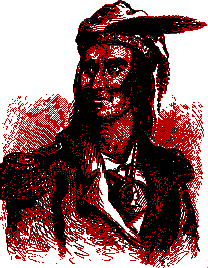
If Depp wanted to inspire Indian youth, why didn't he have Tonto do something similar?
Indeed, how is any half-crazed person supposed to be a role model for youngsters? Is Depp advising modern Indians to hit their heads, leave their tribes, and "go crazy" with solo stunts against the military-industrial complex? Uh, thanks but no thanks.
Challenging the status quo
In the modern era, Native activists occupied Alcatraz and Wounded Knee. Marlon Brando supported these Indians, and Depp supposedly admires both them and Brando. So why didn't his Tonto do something equally rebellious?
The 19th-century equivalent of a radical protest might be the Ghost Dance movement. Suppose Tonto found a magical artifact that would let him dance the white man back to Europe. Suppose a villain wanted the artifact to become ruler of America. There's a movie for you. Life-and-death consequences for the entire country--exactly what Hollywood supposedly likes.
Suppose Tonto vanquishes the villain but decides not to go through with the Ghost Dance. Or suppose he does go through with it and the white man disappears. At the end, we learn the entire 20th century was nothing but a present-day Indian's
nightmare dream.
There's a movie with a pro-Indian message.
Even acting alone, in a traditional Western, Tonto could've begun a guerrilla campaign against settlers a la Geronimo. He could've gone to Washington and tried to assassinate the president. Or if you prefer a nonviolent approach, he could've gone to Congress and demanded his people's rights.
Fighting a single evildoer is
nothing compared to that. It's basically accepting the reality of Euro-American conquest. Which is why critics say most entertainment products--from old Westerns to Karl May's novels to
The Lone Ranger--are pro-American and anti-Indian. They don't challenge the fundamental status quo.
That status quo means exploiting the land, water, and other natural resources for profit. Which is the corporate version of the "American Dream." That's what Disney wants and Depp apparently wants. Namely, to lament the past while lining their pockets and doing little or nothing to change the present.
Except for a few scholarships, even helping Indians seems beyond Disney's and Depp's means. For instance, can they find a few million dollars to buy Wounded Knee for the Lakota, as Depp has hinted at? Apparently not.
Cartoon characters don't deserve America
Throughout its history, Disney has portrayed Indians as comical, clown-like buffoons. Most Native stereotypes--from sports mascots to hipsters in headdresses--do something similar.

Even if the portrayals are dignified--as in Disney's
Pocahontas--they have two things in common. The Indians are primitive and in the past.
The message of these stereotypes is the same. It's to celebrate the American way...maintain the status quo...protect the power and privilege of the white Christian elite. Civilization won and savagery lost, and the spoils go to the victors.
Just look at Tonto or a prancing mascot or a pop star in a headdress. Should we let these weird, backward barbarians stop the march of progress and keep their land and resources? People who go around half-naked, dance and drink, and wear birds on their heads?
That would be crazy, so no. America belongs to the sober, hard-working Christians who "tamed" it, not to heathens who waste their lives partying in skins and feathers. The Disney/Depp message is that Indians were too "different" to own the country, so they had to go.
For more on the subject, see
Onion's Take on Lone Ranger Fiasco and
Depp and Bruckheimer Blame Critics.

